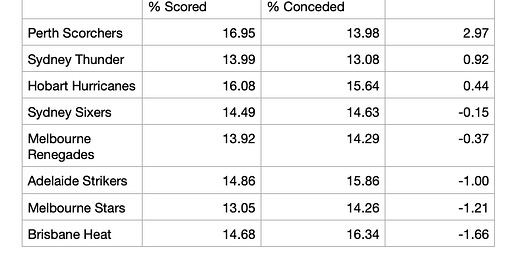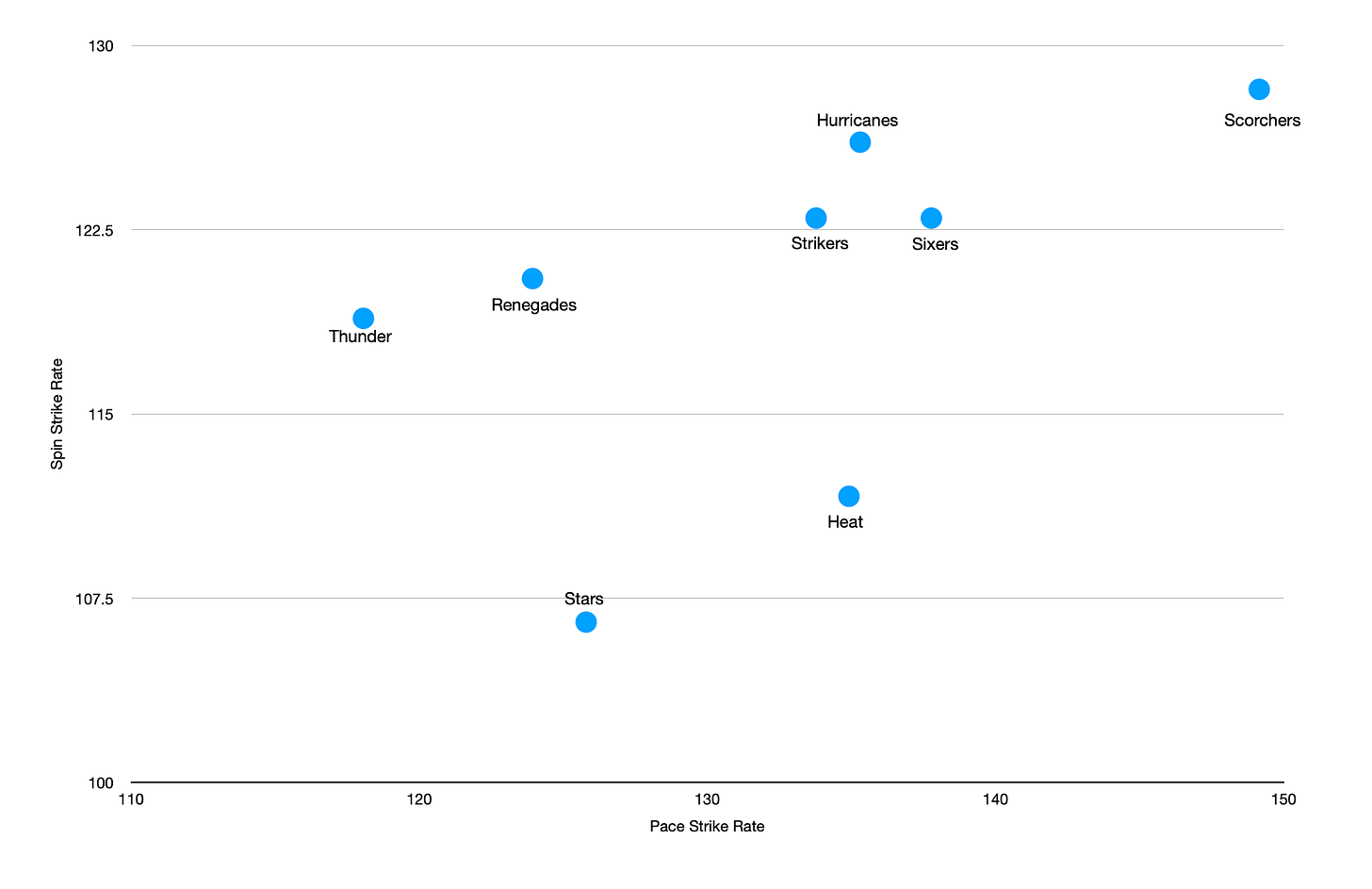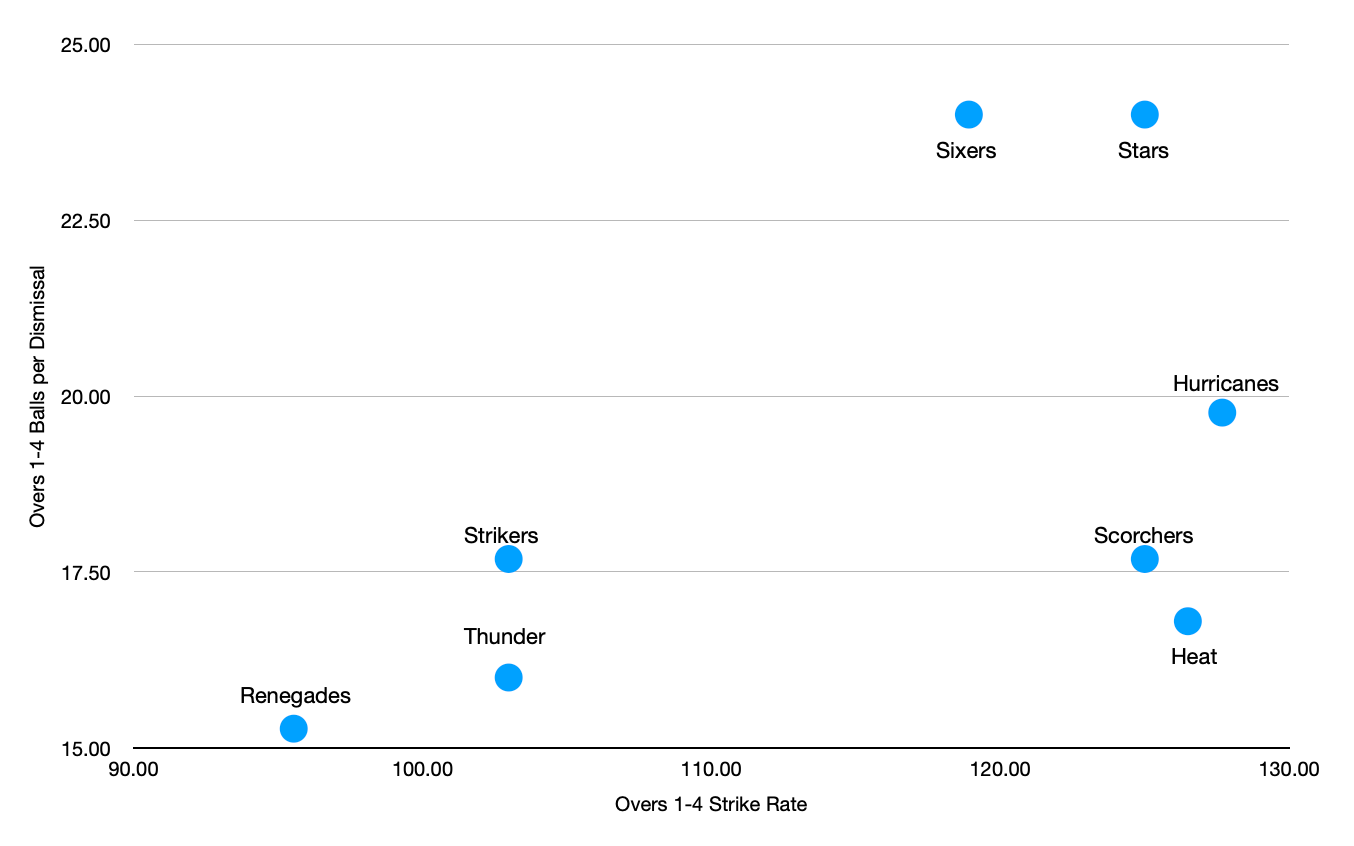There can be little doubt that a 3-11 record represents an extremely disappointing Big Bash season for Melbourne Stars. Following a 6th place last season, and 7th the season before, it appears that the Stars need to make some changes in order to enjoy success, which they had generally been able to achieve in the nine preceding Big Bash seasons (they finished top four in eight of the first nine BBL seasons).
A record of 15-26 over the last three seasons isn’t pretty at all, and hint at there being more reasons for this season’s disappointment than Glenn Maxwell being injured. No doubt, Maxwell’s injury will have been a huge blow for the Stars, but every team loses key players to injury from time to time and it’s important to have a strong enough list to cope with the odd injury or two.
As I mentioned in my Big Bash group stage analysis post yesterday, Stars’ issues this season largely stemmed from disastrous batting performance. As a reminder, here’s some data to re-iterate this assertion.
First up, boundary-hitting and boundary conceding data from the group stage, leading to net boundary percentage - a key driver for T20 success:-
Stars came second-bottom of this chart sorted by net boundary percentage (they conceded 1.21 boundaries per 100 balls more than they scored, equating to 5-6 runs in boundaries per 120 ball innings on average). However, as can be seen above, their boundary prevention was actually pretty good - only Scorchers and Thunder conceded a lower percentage - but the main issue was their batting, which barely reached 13% boundaries hit. Considering the average IPL and Blast teams hit around 17%, this is quite the shortfall - over a 120 ball innings, the difference between 17% and 13% boundaries is around 5 boundaries per innings, so around 22-23 runs on average as a shortfall.
Spin-hitting was a particular issue for Stars:-
A strike rate of around 106 versus spin shows that the Stars batting group did not impose themselves on opposition spinners in general, and their balls per dismissal count of 28.42 against spin is far too high. There needs to be more of a balanced trade-off in terms of wicket preservation versus intent, with something like 125SR/22BPD much more optimal.
Up front with the bat, Stars fared pretty well:-
Closest to the ideal top-right corner, Stars performed best in the Powerplay with the bat of all eight teams. So the blame can’t be laid at the door of Joe Clarke or Tom Rogers in the Powerplay at least.
However, Clarke struck at just 124 in the competition and Rogers at 123, so their hitting clearly went awry after the first four overs, when they struck at 128 and 130 respectively. Even these Powerplay numbers aren’t superb, but they do fall in line with a general reticence for BBL teams to exploit the field restrictions in the first four overs.
As an informed reader might anticipate given a low team batting boundary percentage and the best Powerplay output of all teams, that things would go wrong for Stars after the Powerplay, and that would definitely be correct. Here’s performance for overs 5-16 (middle overs):-
Middle overs strike rate for the Stars was the worst of all teams in the group stage by some distance. Hilton Cartwright and Beau Webster faced over 400 balls between them in the middle overs and combined, hit at below 110 in this phase and hit 9.44% boundaries combined. Throw in the similar numbers of Nick Larkin, who struck at 110 with 10.14% boundaries, and the post-overs 1-4 slowdown from Clarke and Rogers, it’s pretty obvious where it went wrong for the Stars batting group.
With the exception of Rogers, the other four had solid balls per dismissal counts across these overs, so there looks like an evident emphasis on wicket-preservation after the first four overs, with too many negative shot options taken. Unfortunately, T20 cricket is a game of risk v reward, and not taking enough risks means that not enough rewards will be generated either. Quite simply, you have to risk failure to succeed.
The theme of wicket preservation was also evident during the death overs (17-20):-
There’s no need to have such a high balls per dismissal figure in conjunction with a low strike rate at the death. This is the time where teams have to take risks, and it appears Stars were more reticent than other teams to do so.
All combined, it leads to some boundary percentage figures for Stars players which, to be blunt, aren’t particularly pretty:-
Of the batters above (50+ ball Stars batters) only Marcus Stoinis can say that they hit an above-average boundary percentage, while the four players to the left of this chart really struggled to hit to or clear the ropes as much as the average BBL batter - these numbers really need to be dramatically improved for these players batting to be useful to a T20 team. Larkin and Cartwright’s numbers this season look far too focused on wicket preservation than hitting, with unnecessarily high balls per dismissal counts but low boundary percentages. These batters must be encouraged to take more attacking options if Stars are to change their fortunes.
Were these issues foreseeable? Here’s a chart looking at two-year BBL performance for Stars’ batters:-
Clarke and Cartwright had much better numbers in the 2021/22 season, but in that season Webster struck at 103 and Larkin, 91. Joe Burns’ strike rate was in between those two, hitting at 96 with 7% boundaries in the six matches in which he played.
Considering the above, it seems fairly obvious that the Stars batting group needs a big overhaul. In an ideal world Maxwell and Stoinis would be 100% available, while Clarke has shown enough ability in other leagues, and in the 2021/22 season to show he can have a big impact as well. Cartwright clearly has ability but needs to be encouraged to play with far greater intent than he showed this season.
After this quartet, external batting recruitment should be strongly considered. It’s imperative not to have a batting group so greatly polarised in ability and intent (Adelaide Strikers have a similar issue). In addition, high potential and high intent young batters should be recruited to put pressure on existing team members, to build a culture of encouraging brave, positive cricket as opposed to risk averse wicket preservation.
With the ball, a bowling attack of Zampa, Wood, Boult and Coulter-Nile should be more than adequate, and indeed it proved with creditable bowling numbers across phases. Wood is much better than his numbers indicated, while Liam Hatcher also showed ability this season as well.
However, a lack of spin options is an area which needs to be addressed. Clint Hinchliffe was sparingly used, often leaving Zampa as the sole main spinner in the group. Given the issues of many BBL batters against spin - particularly from an intent perspective - bowling more spin overs would be very useful indeed.
In phases, Hatcher’s numbers in the Powerplay were strong, and with Wood, formed a pretty effective bowling duo in the first four overs. Boult disappointed in this phase but has been a proven quantity over a number of years as a Powerplay bowler.
Death bowling was more of an issue. Wood was the only pacer to bowl more than seven overs for Stars between overs 17 and 20, and he went at an economy rate well north of 10, so finding a domestic solution for this skillset looks mandatory in order to improve.
Key retentions:-
Glenn Maxwell, Marcus Stoinis, Joe Clarke, Adam Zampa, Nathan Coulter-Nile
Other considerations for retention:-
Hilton Cartwright, Liam Hatcher, Clint Hinchliffe, Tom Rogers, Beau Webster (with the proviso that he showcases his obvious power as opposed to run-a-ball type innings)
Required skillsets for recruitment (with at least two overseas slots to use as well):-
High intent batters
An additional top 5 batter who is a left-hander as a match-up breaker
Ideally one of the batters recruited to be at least a competent match-up spinner
High quality all-rounder
Two proven death bowlers
High potential young players who can grow with the team and challenge for a first-team spot
If you are working with a BBL team (or any T20 franchise team) please feel free to drop me an email at sportsanalyticsadvantage@gmail.com and we can discuss how the data and analysis work I supply to teams can be of assistance to you.










I still think that Dave Hussey didn't plan well, when he bought 2 overseas pacers, when he had Hatcher and Coulter-Nile in their attack. He could have invested that pick on a good overseas middle order batter (like Iftikhar)